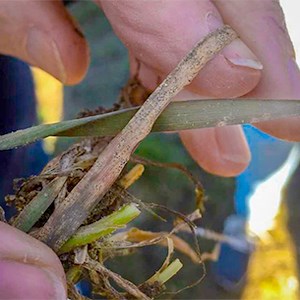Contact
mukesh.dubey@slu.se, 018-672540
Ramesh.Vetukuri@slu.se, 040 41 53 40

Small RNAs are common in fungi, including fungi that can be used as biocontrol agents in agriculture, horticulture, and forestry. In a new review, SLU scientists highlights the diverse function of small RNAs and their potential to manage plant diseases and insect damage in agriculture.
Fungi live in different environments and compete with each other for nutrients and space. They can interact by competing for resources, using antibacterial substances, or directly parasitize hosts. Some fungi thrive by killing other fungi, insects, and nematodes. Certain species also interact with plants, helping them stay healthy and triggering immune responses. Fungi used for controlling plant diseases and pests in agriculture, horticulture, and forestry are called biocontrol agents. They rely on one or more of the properties mentioned above for their effectiveness.
Small RNAs can mediate gene expression regulation through a mechanism known as RNA silencing. In fungi, RNA silencing plays a crucial role in many biological processes, including both parasitic and mutualistic interactions between fungi and plants. Genes encoding proteins involved in the production of small RNAs are present in most fungi, including biocontrol agents.
In a new review article, researchers from SLU summarizes recent findings on the role of RNA silencing in parasitic fungus-fungus and fungus-insect interactions in relation to their use for the biological control of fungal plant diseases and insect damage.
– If you disrupt the RNA silencing machinery in biocontrol fungi, this has major effects on the effectiveness of biocontrol agents. Many small RNAs are produced all the time but are regulated in a different way when they interact with hosts, says Ramesh Vetukuri.
– Some sRNAs even infiltrate host cells, manipulating the host's RNA silencing mechanism to their advantage. Certain sRNAs can act as master regulators and influence the expression of many genes by targeting important proteins that control how the DNA is expressed, says Mukesh Dubey.
Cross-species RNA silencing is a new research field in the study of antagonistic interactions.
– Very small sRNA, called microRNA, of the fungus Beauveria bassiana targets genes involved in the immune response of mosquitoes. We also have indications that the biocontrol fungus Chlonostachys rosea targets virulence factors in its pathogenic host fungi.
– This is a very interesting research area that can be of great importance for our food security. However, there are certainly difficulties that we need to tackle to study cross species RNA silencing such as difficulties to separate bioinformatic data from mycoparasites from their hosts, concludes Edoardo Piombo.
mukesh.dubey@slu.se, 018-672540
Ramesh.Vetukuri@slu.se, 040 41 53 40
Read the scientific article “Small RNAs: A new paradigm in fungal-fungal interactions used for biocontrol” in the journal Fungal Biology Reviews.